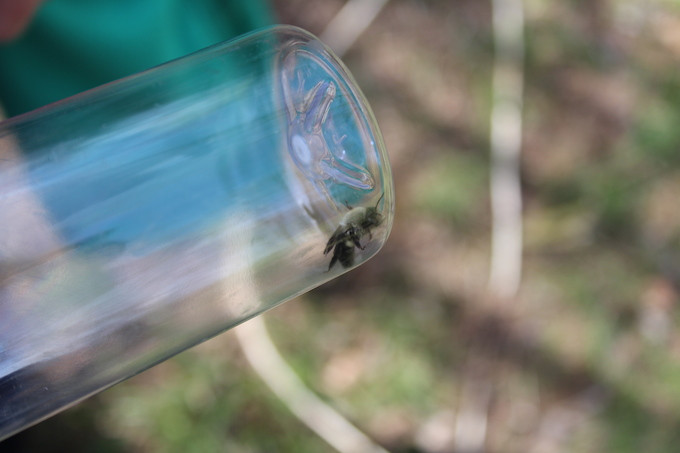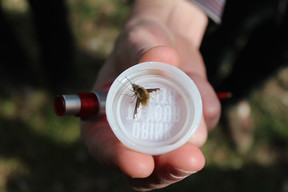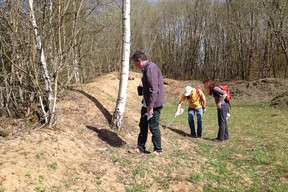Luxembourg has around 300 different bee species and on 12 April a group of us went to visit some of them at the Remerchen ponds, near Wintrange. Under a warm sun, we followed our guide, Fernand Feitz of natur&ëmwelt, to some nesting sites of these solitary bees.
Fernand came prepared with a small net and some plastic bottles. He proceeded to catch bees and transfer them gently from net to bottle so we could take a closer look. First, a mining bee, with a silvery-grey colour; they make nests of tunnels in the ground. Next, a couple of parasite bees who survive by laying their eggs in other bees’ nests.
Then more bees with shades of yellow, brown and red; small, medium and large. We smiled when we heard that male bees have visibly more facial hair than females. We learned that the polyester bee, who appears later in the year, is so-named as they make a silk-like material in the nest to protect their larvae against humidity. And the ivy bee, which is an oligolectic bee species, meaning they feed their larvae with pollen of specific plants only.
Unlike the honeybee, solitary bees live on their own; they make their individual nest in mounds of earth or holes in walls or tree trunks. Although nests are individual, the bees may nest in large numbers in the same mound of earth. Other bees will nest in empty snail shells or the pile of branches sitting in your garden. The good news is you can spend less time tidying up garden waste, as bees and other insects need this natural debris for habitat. Win-win!
Nests not hives
A solitary bee’s ground nest will have a small entrance, which may be covered over, to try to protect against parasites laying eggs near the bee’s larvae. The nest may have several tunnels forming both nursery and larder for larvae to grow safely with pollen and nectar supplied by the female. The male bees don’t have nests; they live out their short lives in the great outdoors.
Finally, unlike honey bees, solitary bees do not survive over winter. Instead their larvae will emerge in the spring to continue their species’ existence. So it’s very important to have a range of plants and trees in your garden which flower from early spring right through to the end of the year to support solitary bees and other pollinators in their endless quest for nectar and pollen.
If you want to learn more about how to help solitary bees and other pollinators, you can read the “Bee in Solidarity with Pollinators” brochure.
Noelle Buckley is a volunteer with Bee Together. The group hosts “Bee informed-biodiversity”, an event on what “helps and hinders” biodiversity, on Sunday 14 June at 10am. For more information about Bee Together’s activities, sign up on its mailing list, and for more info about natur&ëmwelt, sign up for its newsletter.





























